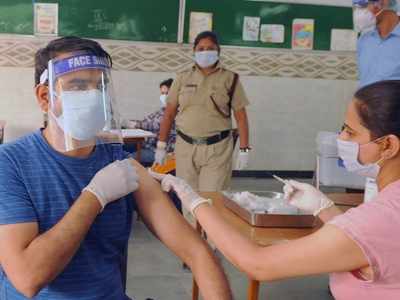- News
- India News
- Covid-19: Experts say one vaccine dose enough for five people
Trending
This story is from June 17, 2021
Covid-19: Experts say one vaccine dose enough for five people
Given the acute shortage of Covid-19 vaccines, one way to ramp up the vaccination programme is by providing a smaller quantity of the vaccine in an intradermal (ID) way, said experts. This means injecting 0.1ml into the skin, which is a fifth of the volume of the current dose of 0.5ml given intramuscularly in the shoulder. In short, a 0.5ml dose now given to one recipient will be able to vaccinate five persons by the intradermal route.

BENGALURU: Given the acute shortage of Covid-19 vaccines, one way to ramp up the vaccination programme is by providing a smaller quantity of the vaccine in an intradermal (ID) way, said experts.
This means injecting 0.1ml into the skin, which is a fifth of the volume of the current dose of 0.5ml given intramuscularly in the shoulder. In short, a 0.5ml dose now given to one recipient will be able to vaccinate five persons by the intradermal route.
“This is done successfully in rabies vaccination. The concentration of antigen-processing cells in the skin is responsible for the strong immunologic response to vaccines administered through the skin, despite the lower amount of vaccines injected. An intradermal shot is expected to stimulate precisely the regional lymph nodes and quickly generate an immune response that is sometimes better than the intramuscular response,” said Technical Advisory Committee chairman Dr MK Sudarshan, who has the expertise of working on rabies vaccines.
The concentration of antigen-processing cells in the skin is responsible for the strong immunologic response to vaccines administered through the skin, despite the lower amount of vaccines injected. An intradermal shot is expected to stimulate precisely the regional lymph nodes and quickly generate an immune response that is sometimes better than the intramuscular response,” said Technical Advisory Committee chairman Dr MK Sudarshan, who has the expertise of working on rabies vaccines.
The Union government has to take up the matter with the manufacturing companies to conduct a study on the same, Dr Sudarshan added.
According to him, a well-planned clinical trial may be conducted involving 10 healthy volunteers each for Covishied and Covaxin.
“The study, with necessary approvals from the ethics committee of a medical college, can check whether the vaccines are safe and immunogenic when given through intradermal route. A dose of 0.1ml is given in the ID route on days zero and 28. The antibody response in the vaccinated persons may be checked four weeks after each dose through tests. These studies can be fast-tracked and conducted in three months,” Dr Sudarshan added.
This means injecting 0.1ml into the skin, which is a fifth of the volume of the current dose of 0.5ml given intramuscularly in the shoulder. In short, a 0.5ml dose now given to one recipient will be able to vaccinate five persons by the intradermal route.
“This is done successfully in rabies vaccination.

The Union government has to take up the matter with the manufacturing companies to conduct a study on the same, Dr Sudarshan added.
The World Health Organization approved intradermal rabies vaccination in the 1980s and India introduced it in 2006. “Rabies is practically 100% fatal and IDRV (intradermal rabies vaccination) is successfully used to treat and prevent rabies in those bitten by rabid animals. On the contrary, Covid-19 is fatal in less than 1% of those infected and the Covid vaccine is given to prevent the disease in healthy adults as preventive vaccination,” said Dr Sudarshan.
According to him, a well-planned clinical trial may be conducted involving 10 healthy volunteers each for Covishied and Covaxin.
“The study, with necessary approvals from the ethics committee of a medical college, can check whether the vaccines are safe and immunogenic when given through intradermal route. A dose of 0.1ml is given in the ID route on days zero and 28. The antibody response in the vaccinated persons may be checked four weeks after each dose through tests. These studies can be fast-tracked and conducted in three months,” Dr Sudarshan added.
End of Article
FOLLOW US ON SOCIAL MEDIA










